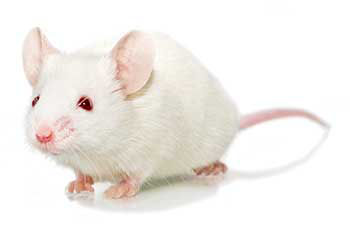Application Areas:
FcResolv® hIL-15 NOG
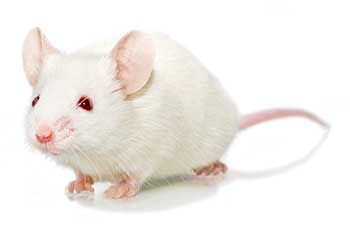
| Model No. | Nomenclature | Genotype |
|---|---|---|
| 19220-F | NOD.Cg-Fcgr2btm1Ttk Fcer1gtm1Rav Prkdcscid Il2rgtm1Sug Tg(CMV-IL2/IL15)1-1Jic/JicTac | ko/ko;ko/ko;sp/sp;ko/ko;tg/wt |
| 19220-M | NOD.Cg-Fcgr2btm1Ttk Fcer1gtm1Rav Prkdcscid Il2rgtm1Sug Tg(CMV-IL2/IL15)1-1Jic/JicTac | ko/ko;ko/ko;sp/sp;ko/y;tg/wt |
- Description
- Data
- Price & Licensing
- Health Report
- Overview
- Genetics
- Guides & Publications
- Applications & Therapeutic Areas
- Transit, Housing & Welfare
- Diet
Overview
Get an accurate assessment of your antibody-based drug efficacy. Murine Fc gamma (Fcγ) receptor knockout in the hIL-15 NOG mouse reduces experimental confounders to get you the right answer faster.
Nomenclature: NOD.Cg-Fcgr2btm1Ttk Fcer1gtm1Rav Prkdcscid Il2rgtm1Sug Tg(CMV-IL2/IL15)1-1Jic/JicTac
- The FcResolv® hIL-15 NOG is a super immunodeficient NOG mouse that expresses human IL-15 to support engraftment of human NK cells and which has a further reduction in residual murine immune activity via ablation of mouse Fc gamma receptors (FcγRs) in order to reduce experimental confounders.
- Murine FcγRs can confound experiments in several ways, leading to false positive or negative results. Removing murine FcγRs provides improved accuracy for efficacy assessment of antibody-based therapies which include an Fc domain.
- Lacks all murine FcγRs, including the FcγRI, IIB, III and IV types, along with the high affinity FcεRI receptor. The low affinity FcεRII receptor remains present.
- Supports engraftment of human NK cells following engraftment with CD56+ NK cells derived from PBMCs and can be used in a similar fashion to the hIL-15 NOG.
- The FcResolv hIL-15 NOG mouse is optimized for engraftment of isolated primary human NK cells, immortalized human NK cell lines or human NK cell therapies. Humanization with HSCs is not recommended in this model. While HSC engraftment results in strong proliferation of NK cells, lifespan post-differentiation is very limited. Humanization of this strain with PBMCs is not recommended as an optimal model to study human NK cells, but may be of interest for GvHD applications.
- Useful for efficacy studies involving antibody therapeutics with antibody-dependent cell cytotoxicity (ADCC) mechanism of action.
- Applications in research involving cancer, infectious disease, immunology, regenerative medicine, and human immune system engraftment.
Orders by weight: Taconic cannot accept orders by weight for this model. Please note that shipments may contain animals with a larger weight variation.
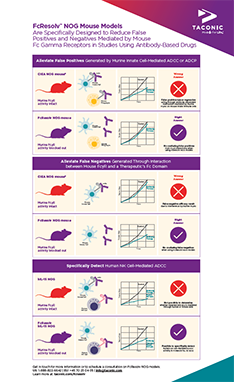 Download the Taconic Biosciences Infographic:
Download the Taconic Biosciences Infographic:FcResolv® NOG Mouse Models Are Specifically Designed to Reduce False Positives and Negatives Mediated by Mouse Fc Gamma Receptors in Studies Using Antibody-Based Drugs
See how the FcResolv hIL-15 NOG mouse reduces experimental confounders.
Availability
Available now**Please note that advanced order placement is encouraged for male mice. Ordering 4 or more weeks prior to the desired shipping date is recommended when requesting males older than 3 weeks of age.
Recommended Controls
The recommended control for this model is hIL-15 NOG.
Origin
The FcResolv hIL-15 NOG mouse was developed by Takeshi Takahashi of the Central Institute for Experimental Animals (CIEA) in Japan. The Fcer1gtm1Rav mutation was developed in the laboratory of J.V. Ravetch, Sloan-Kettering Institute. The Fcgr2btm1Ttk mutation was developed in the laboratory of T. Takai of Okayama University. These two mutations were backcrossed onto the CIEA NOG mouse®, and the resulting FcResolv NOG mouse was crossed to the hIL-15 NOG to generate the FcResolv hIL-15 NOG. Taconic received stock in 2021, and the line was derived through embryo transfer. The mice are maintained by breeding females homozygous for the Fcer1gtm1Rav, Fcgr2btm1Ttk, Prkdcscid and Il2rgtm1Sug mutant alleles with males that are homozygous for the Fcer1gtm1Rav, Fcgr2btm1Ttk, Prkdcscid alleles and hemizygous for the Il2rgtm1Sug mutant allele and hIL-15 transgene or females homozygous for the Fcer1gtm1Rav, Fcgr2btm1Ttk, Prkdcscid and Il2rgtm1Sug mutant alleles and hemizygous for the hIL-15 transgene by males homozygous for the Fcer1gtm1Rav, Fcgr2btm1Ttk, Prkdcscid alleles and hemizygous for the Il2rgtm1Sug mutant allele.
Genetics
Guides & Publications
Initial Publication:
Katano I, Ito R, Kawai K, Takahashi T. Improved Detection of in vivo Human NK Cell-Mediated Antibody-Dependent Cellular Cytotoxicity Using a Novel NOG-FcγR-Deficient Human IL-15 Transgenic Mouse. Front Immunol. 2020 Oct 7;11:532684.
Applications & Therapeutic Areas
- Immunology
- Inflammation
- Oncology & Immuno-Oncology
- Cell and Tissue Humanized
Transit, Housing & Welfare
Need more info? Click the live chat button or Contact Us
Packing Practices
Taconic standard practice is to recombine animals of different home cages and/or ages from a single model and sex during packing, except in specific cases where Taconic's animal welfare policy prohibits recombination due to aggression or other concerns. When an order is fulfilled with animals from more than one week of birth, this standard practice results in animals from a range of birth weeks packed together in a single TTC. When an order is fulfilled with animals from genotyped models, this standard practice results in animals from different home cages packed together in a single TTC.
Customers who wish to keep animals from different weeks of birth separated should place orders with the special instruction "Divide and label by age." Note that this special request can result in increased costs for additional Taconic Transit Cages, dividers and/or freight charges.
Taconic discourages other types of custom packing requests as they can have a negative impact on animal welfare. Learn more.
Diet
Data
FcResolv hIL-15 NOG Permits Specific Detection of Effects Mediated Through Human NK Cells
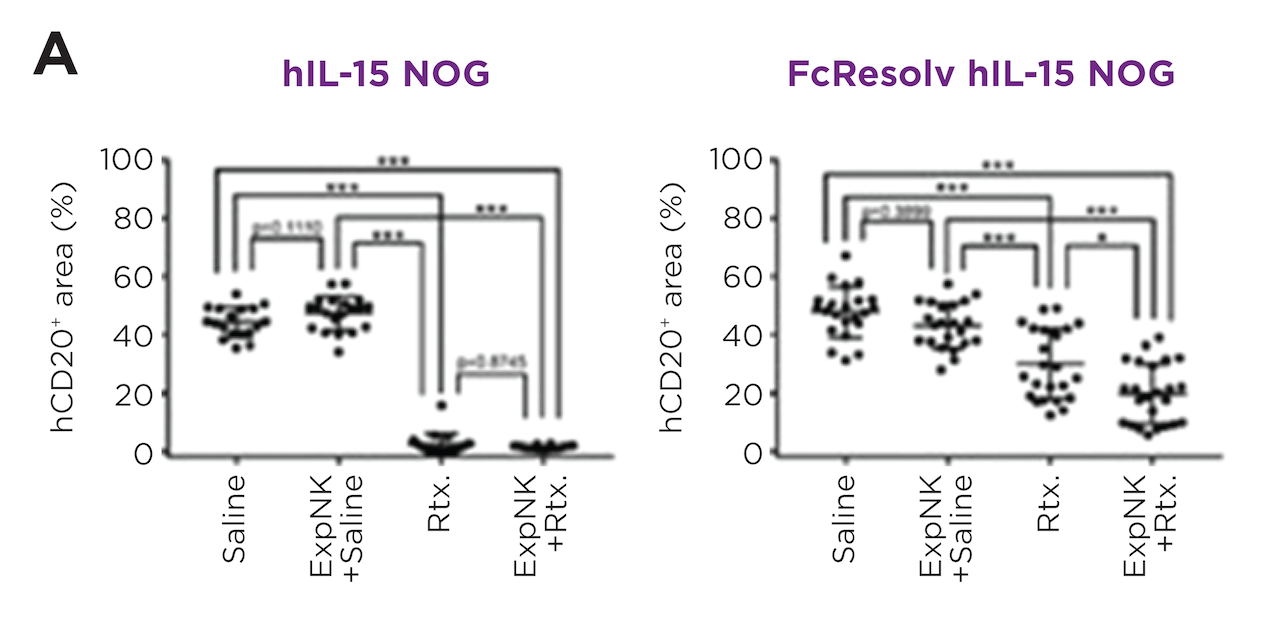
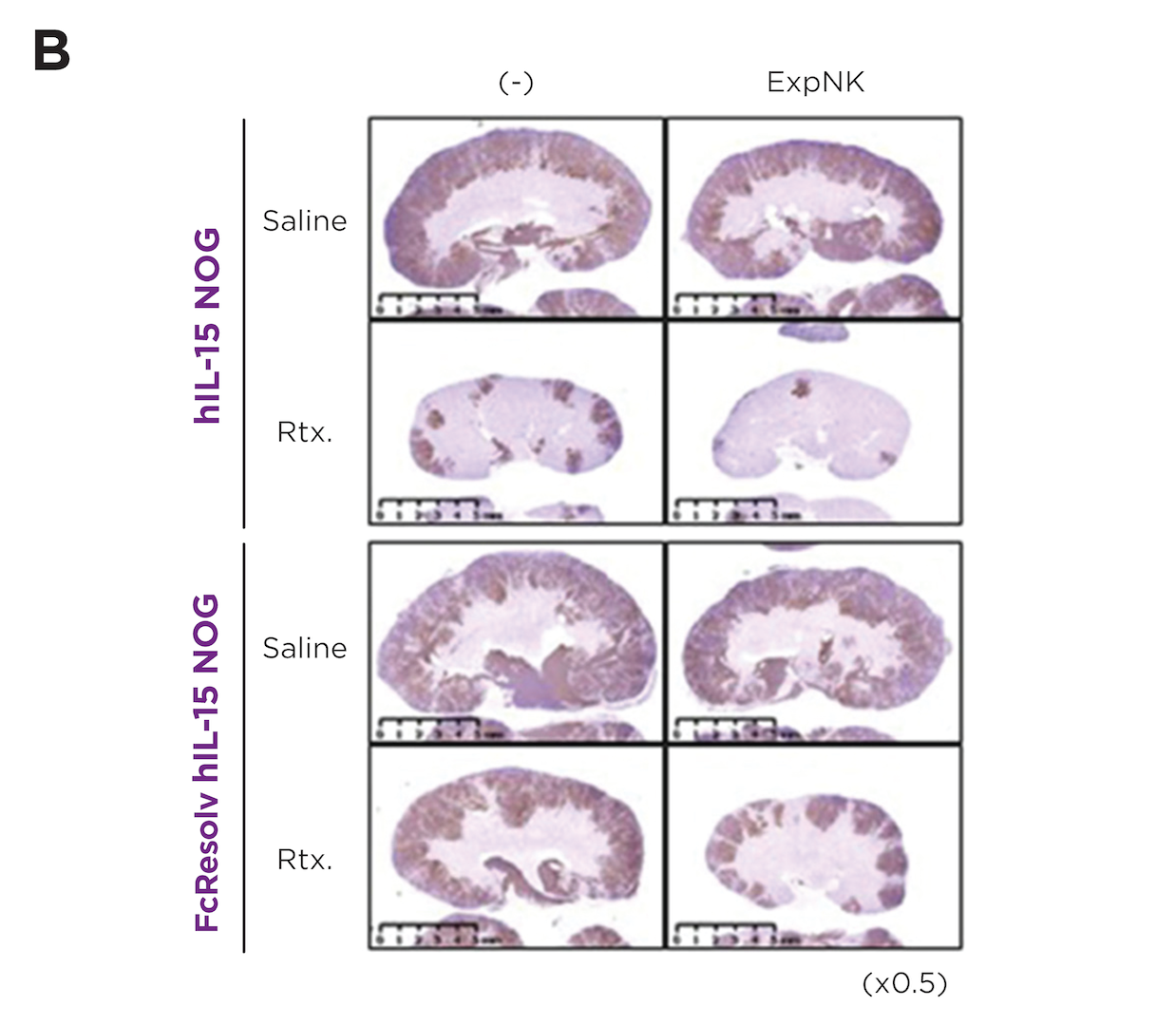
Figure 1: FcResolv hIL-15 NOG mice specifically identify anti-tumor effects mediated by human cells. In hIL-15 NOG mice, strong anti-tumor activity against Daudi cells was seen with rituximab, regardless of whether human NK cells were present, indicating a strong effect mediated through murine innate cells. While rituximab alone showed some effect in FcResolv hIL-15 NOG mice, rituximab plus human NK cells showed the largest decrease in Daudi cell dissemination compared to saline or saline + human NK cell controls. It is thus possible to specifically detect human NK cell-mediated ADCC in the FcResolv hIL-15 NOG strain. A) Representative images of immunohistochemistry of kidneys. B) Daudi cell dissemination was measured via immunohistochemistry using automated image analysis of kidney sections. From Katano 2020.
FcResolv hIL-15 NOG Supports Engraftment of Human NK Cells

Figure 2: FcResolv hIL-15 NOG mice support the engraftment of expanded human NK cells with engraftment levels and persistence similar to the base hIL-15 NOG mouse. From Katano 2020.
- Licensing
- Pricing - USD
- Pricing - EUR
- Pricing - DKK
- Pricing - USD Nonprofit
- Pricing - EUR Nonprofit
- Pricing - DKK Nonprofit
- Select my Health Standard
- Get Custom Pricing Guide
FcResolv® hIL-15 NOG
Nonprofit users (excluding users at nonprofit foundations which are affiliated with a for-profit entity): For internal research purposes, the CIEA NOG mouse® Conditions of Use for nonprofit users apply. If you wish to perform sponsored research or fee-for-service contract research using the CIEA NOG mouse®, please inquire for access conditions.
For-profit users and users at foundations which are affiliated with for-profit entities: The CIEA NOG mouse® Conditions of Use for for-profit users apply.
The CIEA NOG mouse® is produced and distributed under license rights to the following patents and trademarks:
- Japanese Patent No. 3,753,321
- US Patent No. 7,145,055; 5,464,764; 5,487,992; 5,627,059; 5,631,153; 5,789,215; 6,204,061; 6,653,113; 6,689,610
EP Patent No. 1,338,198 - Japanese Trademark Reg. No. 4,823,423
- US Trademark Reg. No. 3,118,040
- EU Trademark Reg. No. 3,736,758
Pricing - USD
Opportunist Free (OF) Health Standard
19220 Female
19220-F Genotype ko/ko;ko/ko;sp/sp;ko/ko;tg/wt
Available now
| Age in Weeks | Quantity 1 - 999 |
|---|---|
| 5 to 10 | US$394.00 |
19220 Male
19220-M Genotype ko/ko;ko/ko;sp/sp;ko/y;tg/wt
Cohorts are reserved upon order placement and will take 4-8 weeks to fulfill. An estimated lead time will be provided to you within 2-3 business days.
| Age in Weeks | Quantity 1 - 999 |
|---|---|
| 5 to 10 | US$276.00 |
Pricing - EUR
Opportunist Free (OF) Health Standard
19220 Female
19220-F Genotype ko/ko;ko/ko;sp/sp;ko/ko;tg/wt
Available now
| Age in Weeks | Quantity 1 - 999 |
|---|---|
| 5 to 10 | 358,00 € |
19220 Male
19220-M Genotype ko/ko;ko/ko;sp/sp;ko/y;tg/wt
Cohorts are reserved upon order placement and will take 4-8 weeks to fulfill. An estimated lead time will be provided to you within 2-3 business days.
| Age in Weeks | Quantity 1 - 999 |
|---|---|
| 5 to 10 | 251,00 € |
Pricing - DKK
Opportunist Free (OF) Health Standard
19220 Female
19220-F Genotype ko/ko;ko/ko;sp/sp;ko/ko;tg/wt
Available now
| Age in Weeks | Quantity 1 - 999 |
|---|---|
| 5 to 10 | kr.2.660,00 |
19220 Male
19220-M Genotype ko/ko;ko/ko;sp/sp;ko/y;tg/wt
Cohorts are reserved upon order placement and will take 4-8 weeks to fulfill. An estimated lead time will be provided to you within 2-3 business days.
| Age in Weeks | Quantity 1 - 999 |
|---|---|
| 5 to 10 | kr.1.860,00 |
Pricing - USD Nonprofit
Opportunist Free (OF) Health Standard
19220 Female
19220-F Genotype ko/ko;ko/ko;sp/sp;ko/ko;tg/wt
Available now
| Age in Weeks | Quantity 1 - 999 |
|---|---|
| 5 to 10 | US$189.00 |
19220 Male
19220-M Genotype ko/ko;ko/ko;sp/sp;ko/y;tg/wt
Cohorts are reserved upon order placement and will take 4-8 weeks to fulfill. An estimated lead time will be provided to you within 2-3 business days.
| Age in Weeks | Quantity 1 - 999 |
|---|---|
| 5 to 10 | US$169.00 |
Pricing - EUR Nonprofit
Opportunist Free (OF) Health Standard
19220 Female
19220-F Genotype ko/ko;ko/ko;sp/sp;ko/ko;tg/wt
Available now
| Age in Weeks | Quantity 1 - 999 |
|---|---|
| 5 to 10 | 173,00 € |
19220 Male
19220-M Genotype ko/ko;ko/ko;sp/sp;ko/y;tg/wt
Cohorts are reserved upon order placement and will take 4-8 weeks to fulfill. An estimated lead time will be provided to you within 2-3 business days.
| Age in Weeks | Quantity 1 - 999 |
|---|---|
| 5 to 10 | 154,00 € |
Pricing - DKK Nonprofit
Opportunist Free (OF) Health Standard
19220 Female
19220-F Genotype ko/ko;ko/ko;sp/sp;ko/ko;tg/wt
Available now
| Age in Weeks | Quantity 1 - 999 |
|---|---|
| 5 to 10 | kr.1.279,00 |
19220 Male
19220-M Genotype ko/ko;ko/ko;sp/sp;ko/y;tg/wt
Cohorts are reserved upon order placement and will take 4-8 weeks to fulfill. An estimated lead time will be provided to you within 2-3 business days.
| Age in Weeks | Quantity 1 - 999 |
|---|---|
| 5 to 10 | kr.1.145,00 |
Select my Health Standard
Need help choosing the right Taconic Biosciences health standard for your research?
Use the Health Standard Selector to enter your exclusion list. The tool will tell you which health standards meet your requirements.
Get custom pricing guide
Related Models
FcResolv® Resources
Schedule A Scientific Consultation
Speak with a PhD-level Field Application Scientist who can help you select the most appropriate model and maximize your experimental success.
















.jpg)

.jpg)
.jpg)
.jpg)
.jpg)





.jpg)


.jpg)
.jpg)




.jpg)




.jpg)

.jpg)






